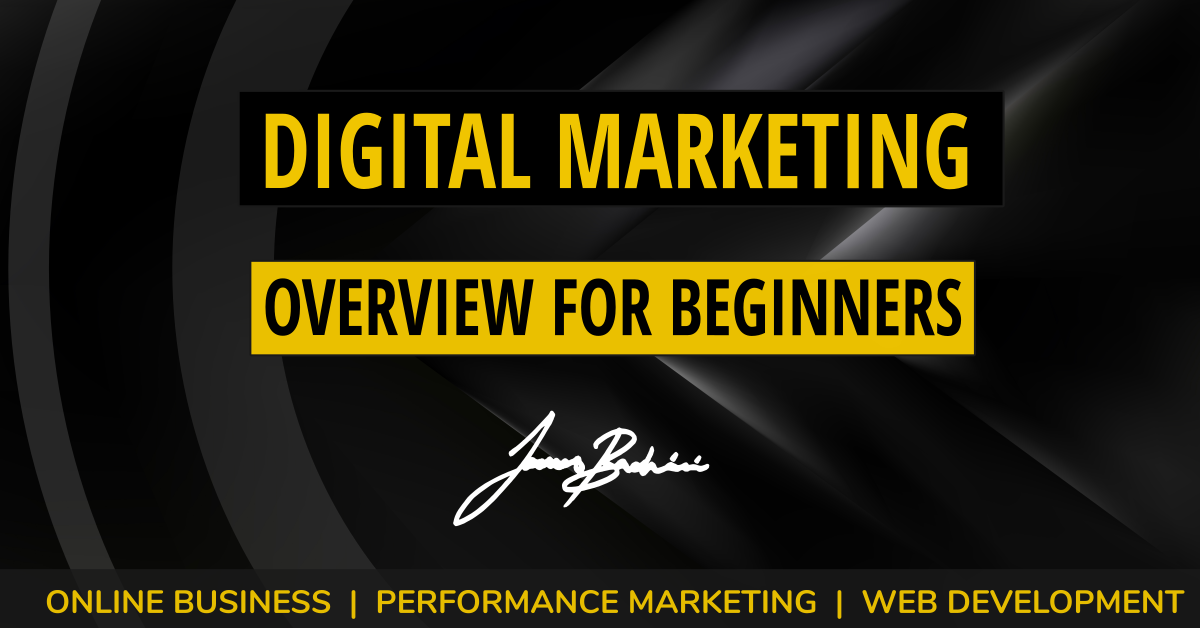In this beginners guide I provide a digital marketing overview of how to setup and run online marketing campaigns. Check out the video and there’s more detailed information below and in the digital marketing tutorials section.
- [Video] Digital Marketing For Beginners
- How Online Marketing Works
- Performance Marketing Process
- Analytics & Tracking
- Website, Landing Page Design and CRO
- Anatomy of a Sales Funnel
- Traffic Sources
- Creative Design Banners & Videos
- Retargeting & Lookalike Audiences
- Optimizing and Continuous Improvement
- Scaling Up Winning Campaigns
[Video] Digital Marketing For Beginners

How Online Marketing Works
Digital marketing is the concept of driving traffic or website visitors to your web properties. Marketers can do this in a number of ways:
- We have short term campaigns but the idea is to get a direct response from that visitor converting them to a lead or customer
- Or we can conduct longer term campaigns where the idea is to build a brand image and create positive associations for that brand
This article is going to be mainly focused on direct response performance marketing. The scientific process of running campaigns, optimizing them to see what works, then building out variations to develop the campaigns in a process of continual improvement.
Performance Marketing Process
Let’s look at and example advertising campaign. In the screenshot below I’ve typed “insurance quote” into Google.
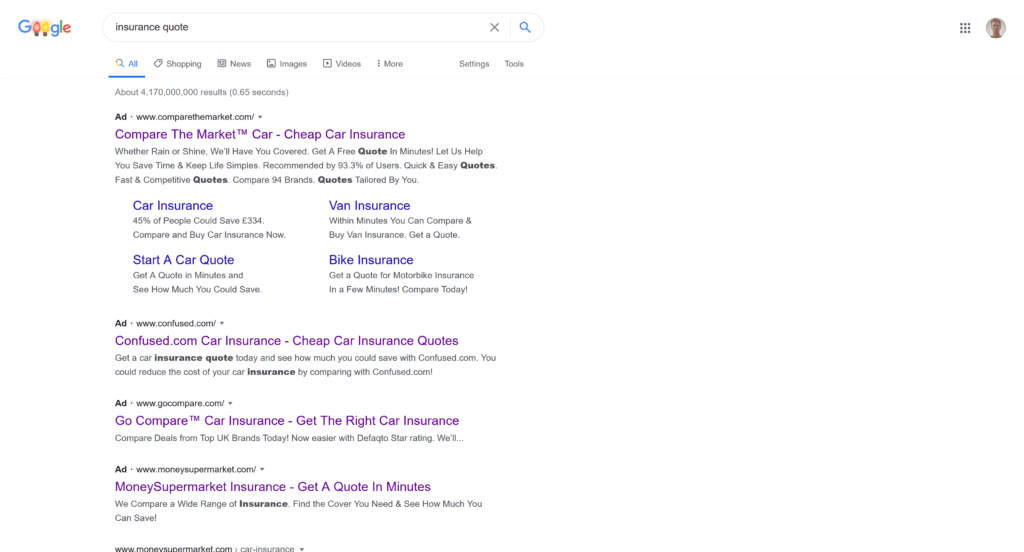
We’re gonna get a bunch of paid ads in the top results. All the ads above the fold (in view) are paid ads which are sold via the Google Ads platform.
If we scroll further down there will be some organic listings. These are the natural listings that aren’t paid for. Marketers win the battle for search engine rankings by either paying for ads or by creating great content and focusing on SEO (search engine optimization).
Not all digital marketing focuses on Google. Social networks like Facebook, Twitter and LinkedIn all have advertising platforms where marketers can purchase digital advertising space for their creatives (aka banners).
You might have heard of AB testing, this is when we have two variations of a landing page and then drive equal amounts of traffic to each. One will perform better, creating more sales than the other one. We take this landing page and build variations of it, then retesting again to continuously improving the performance of the marketing campaign. This doesn’t have to be just landing page for example we can do multivariate testing of different components within a landing page.
Multivariate testing or MV testing is when you test lots of different factors at the same time. You might have different titles, different images a bunch of different bullet points and different button colors. This process of improving the conversion rate of the landing page is called CRO or conversion rate optimization. It’s very rare that I would upload a single banner or a single creative to an advertising campaign. More often than not I’ll be uploading between two and ten banners every few days to a week.
The process of optimization provides insights into what’s works and what doesn’t. Marketers can learn what is driving performance within the campaign from a consumer psychology perspective. By testing different headlines for example we can learn about what buttons to push to convert visitors in to customers.
When setting up initial marketing campaigns it’s a good idea to keep daily budgets quite limited. We don’t spend a lot of money before we know if it’s going to work. Once we have some data in our analytics platform we can scale up the campaigns quite quickly and potentially reach a global audience.
Analytics & Tracking
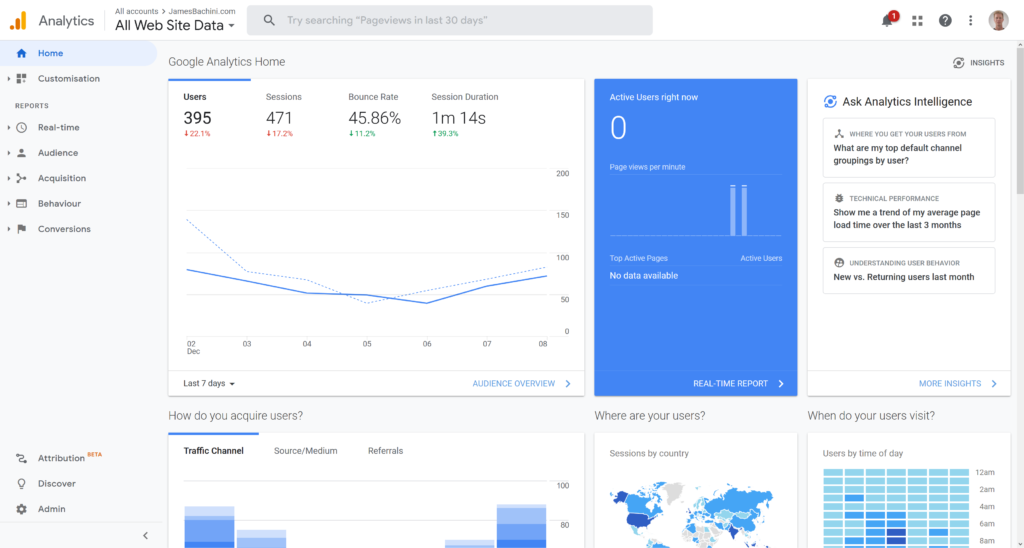
This is Google Analytics, by far the most popular tracking an analytics platform online. The platform is provided for free by Google. It is really simple to install via a plugin for WordPress or you can copy and paste the code on your website.
Google Analytics gives us visitor data about our web properties. We can get demographic data on the type of visitors we are getting. We can also see where those visitors are coming from both geographically and in the online world.
Marketers should set up goals or conversion events using their tracking platform. This is another copy and paste piece of code that will tell Google Analytics when you’ve had a sale or a visitor has filled in a form for example. It’s important that the goals are in line with your key performance indicators. The idea is to be able to go in to the Analytics platform at any time and see where the traffic is coming from and how much money it is making or leads it is sending your business.
Without conversion tracking setup we would be running campaigns in the blind without knowing what is working and what isn’t.
Website, Landing Page Design and CRO
A typical landing page for a performance marketing campaign will have value proposition in the headline, some bullet points offering benefits (not features), a hero image or video demo and a big call to action button so the visitor knows what to do next.

The most effective way to create landing page is to hand code the HTML files. This does require some design and coding skills however. For nocoder’s there is WordPress, a content management platform that 1/3 of the websites online uses.
Additionally you’ll need a domain name and some web hosting. These are affordable and widely available from a variety of sources.
Anatomy of a Sales Funnel
If a landing page is the front end that the website visitor interacts initially with then the sales funnel is the back end. The sales funnel nurtures leads until they are confident in making a purchase.
Here is a typical example of a sales funnel.
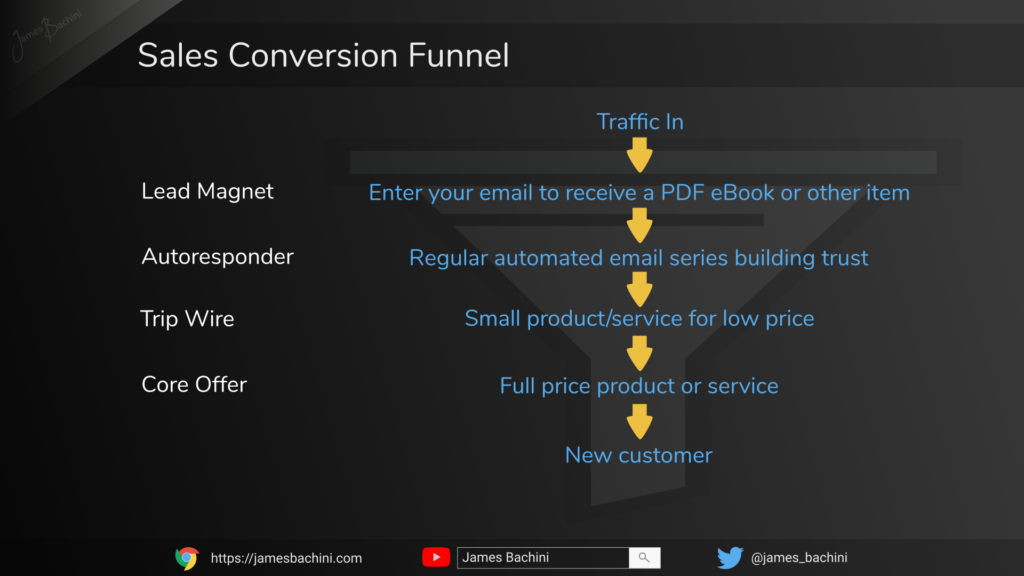
Traffic is driven in to the top of the funnel from external sources such as ad exchanges, social networks and search engines.
The visitor lands on a landing page where they can get a free offer such as an eBook or product trial, this is known as a lead magnet.
A series of automated emails known as an autoresponder will be delivered once the visitor has entered their email address. The idea behind the autoresponder is to build trust through regular communications.
A tripwire is a small product that is designed to be a initial purchase. This should exceed customers value expectations. This is the point when a visitor becomes a customer.
At the final stage of the funnel the visitor has received brand communications, has had a positive purchase experience and is much more likely to commit to the core product and service offerings.
More information on sales funnels here:
https://jamesbachini.com/lead-magnets-autoresponders-tripwires/
Traffic Sources
Traffic sources are where marketers can get traffic or visitors to their website. We can start by splitting traffic sources into 2 categories:
- Paid Traffic – Such as banner ad exchanges and pay per click search ads
- Free Traffic – From search engine organic listings and social media sites
The first thing to note is that free traffic isn’t really free. It takes a lot of time to build out a good content strategy and search engine optimization for your site to start rising up the search rankings. There’s no such thing as a free lunch. SEO is a marathon rather than a sprint and results can take 6-12 months before you start getting visitors.
Paid traffic in contrast is expensive but you can turn it on and off at the flick of a button. It scales fast and for most businesses this will provide the most tangible results. The two largest advertising networks are Google Ads and Facebook Ads.
More about traffic sources here.
Creative Design Banners & Videos
Good ads or creatives as they are known will have a compelling value proposition and a call to action.
On mobile devices particularly advertisers get a very small amount of space to convey what their offer is all about.
For static banners I recommend editing in Inkscape, a free open-source vector graphics program.
Video advertising has revolutionized the industry both on YouTube and in the form of social feed ads. For video editing software I would recommend DaVinci Resolve.
When designing banners there are two distinct methods or angles to take. Either create something that will stand out completely on the publisher website, or blend the ad into the content to look like a native element.
Some of my most successful banner ads have been designed using a screenshot of the publisher website and then designing a banner in place to match the sites colors, fonts and style.
When creating video ads the first 3 seconds are critical. It’s that initial impression that either gains attention or gets swiped away. Think about the videos that go viral and how they surprise and shock the audience. The video should illicit an immediate reaction in the viewer.
If you are struggling to find images and videos for backgrounds in your ads then take a look at Pexels which has free stock footage.
Retargeting & Lookalike Audiences
Retargeting campaigns often provide the best return on ad spend full advertises however they are limited by volume. This is because you are advertising to a limited audience who have either been on your site previously or are already in your customer email list.
This is how retargeting works:
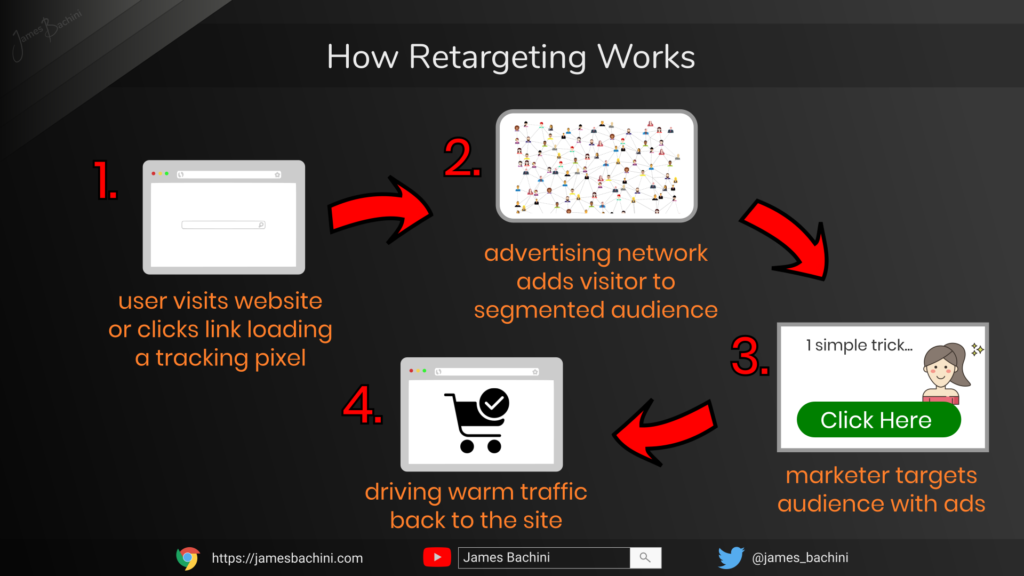
Lookalike audiences are similar but the take a custom audience and the ad network will then go out and match their users who have similar profiles to your custom audience. Essentially finding new users with similar traits to your existing customers and visitors.
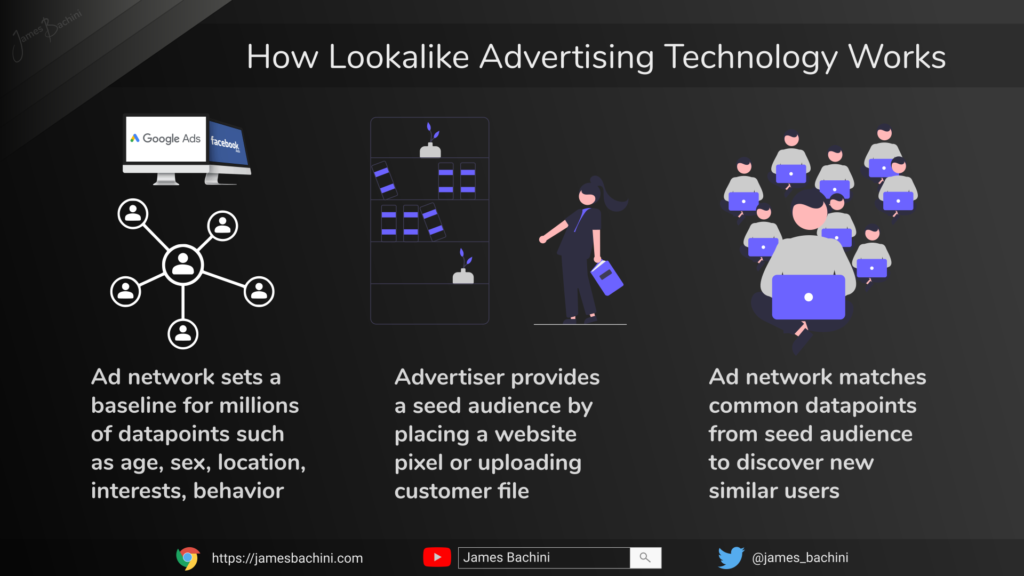
We feed the ad networks data by using their tracking pixels on our website which segments these audiences.
Optimizing and Continuous Improvement
A big part of a digital marketers job is to optimize campaigns. Once there is enough data we will go in to the analytics platform, see what is working and what isn’t then pause any bad campaigns and scale up the winners.
If there is one banner that is outperforming all the others I would create variations on that theme and upload new creatives to keep pushing forwards trying to get the best click through rates and conversion rates I can.
When setting up campaigns on ad networks each campaign will use a tracking URL (website address).
This might look something like this:
https://jamesbachini.com/?utm_source=FacebookAds&utm_medium=Social&utm_campaign=FBAds1
The utm variables in this URL provide Google Analytics with tracking information on where the visitor is coming from. We can add any alphanumeric value in to these variables.
The ad network will send users to that address when the visitor clicks an ad. The utm variables will be tracked behind the scenes by Google Analytics which is installed on the website. Then the advertiser can go in and see exactly how much traffic and how much revenues each campaign is generating.
Conversion Rate Optimization or CRO is the process of developing landing pages and conversion funnels to improve the conversion rate between visitor and customer.

Tests will be hypothesized and variations will be split tested to prove if the hypothesis was correct and the conversion rate increased.
Scaling Up Winning Campaigns
Once a digital marketer has found a winning campaign they will look to scale it up. This increases volumes of users and ultimately profits for the business. Online marketing generally scales really well, especially with paid traffic.
Marketers can scale up very quickly by increasing daily budgets and broadening targeting options. Campaign can be duplicated to new regions and replicated on different ad networks to scale horizontally once a campaign has been proven to work.
When relying on organic free traffic it can be a little more tricky to scale fast. You don’t get the same instant results that you do with paid traffic. However outsourcing can be the answer to increasing content production. This is the process of using employees or virtual assistants to manage some or all of the marketing processes such as editing or writing.
Good luck with your digital advertising! I hope this overview helped. If you are interested in learning more about digital marketing there are more in depth guides to different aspects here: https://jamesbachini.com/learn/
✅ If you’ve enjoyed these resources could you help share this content on social media and send it to anyone who you think might benefit. It helps me out a lot!
Thank you.


